Arizona is home to the highest number of rattlesnakes in the United States. There are at least 15 different types of rattlesnakes in Arizona. However, these snakes are spread out across large spaces and prefer to stay away from humans as much as possible.
In fact, 60-70% of all rattlesnake bites in Arizona occur when humans try to move, capture, or provoke a rattlesnake. Four species of rattlesnakes are protected by Arizona state law, and hunting any of the other types of rattlesnakes requires a license.
So, what types of rattlesnakes live in Arizona? Let’s take a closer look at some of these fascinating animals!
1. Western Diamondback Rattlesnake

The western diamondback rattlesnake has very distinct black and white bands along the end of its tail.
©Alexander Wong/Shutterstock.com
| Western Diamondback Rattlesnake | |
|---|---|
| Range | Widespread throughout Arizona |
| Length | 48-72 inches |
The Western Diamondback Rattlesnake is widespread throughout Arizona, although it is most commonly found in southwest desert areas. It is the largest rattlesnake in the state, growing from 3-6 feet in length. It can also be found throughout the southwestern U.S. and northern Mexico. This snake is the most well-known species of rattlesnake in every area it lives in.
This is partially due to the aggressive nature of the western diamondback rattlesnake. When it feels threatened, it will usually raise its body up in a defensive position and rattle loudly. This snake will not back down and is much quicker to attack than other species of rattlesnakes.
It is usually only out during early mornings and late afternoons when the temperature is not as hot, or at night when it hunts for food. Regardless, the western diamondback rattlesnake is commonly seen in many places in Arizona.
Western diamondback rattlesnakes are usually tan or gray (there are some groups that are also pinkish) with their namesake “diamond” markings running along the length of is bodies. The end of the snake’s tail is decorated with alternating black and white colored bands. The Western diamondback rattlesnake is protected by Arizona state laws and cannot be collected or hunted without a license.
2. Mojave Rattlesnake
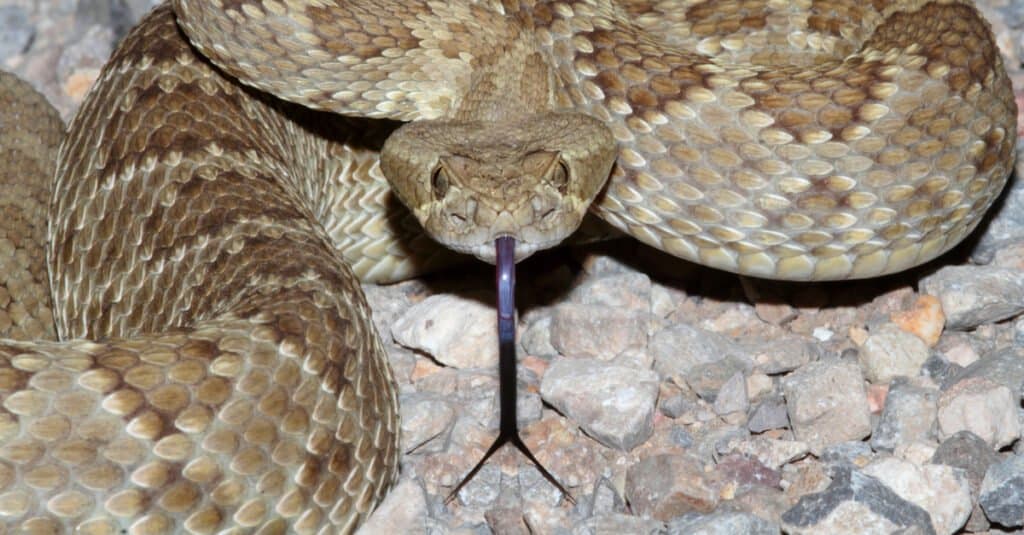
The Mojave Rattlesnake is widely considered the most deadly snake in the United States.
©Steve Byland/Shutterstock.com
| Mojave Rattlesnake | |
|---|---|
| Range | Most of Arizona |
| Length | 39-54 inches |
The Mojave Rattlesnake, or the Mojave Green, is a large snake found throughout most of Arizona. This snake ranges from 39-54 inches long, with a heavy body that is gray, yellow-gray, green-gray, or brown, with dark diamond-shaped splotches along its back.
Mojave rattlesnakes in lower elevations of Arizona are various shades of brown, often with a greenish hue. Snakes in higher elevations near the mountains tend to be darker and greener in color. The Mojave rattlesnake also has a white band on its tail, just before the rattle.
Mojave rattlesnake venom is extremely potent. In fact, it has such a potent mix of neurotoxins and hemotoxins in its venom, that the Mojave rattlesnake is one of the most dangerous snakes in North America. These snakes are most often found in desert scrub, plains regions, and grasslands.
3. Speckled Rattlesnake
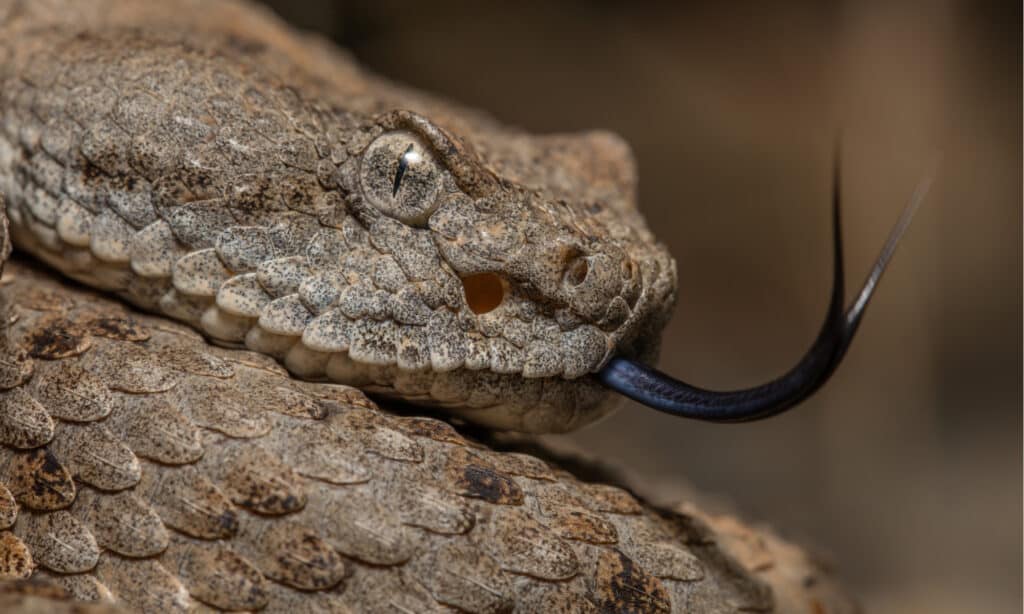
The Speckled Rattlesnake is a master of camouflage and looks exactly like the speckled rocks surrounding it.
©Alexander Wong/Shutterstock.com
| Speckled Rattlesnake | |
|---|---|
| Range | Western Arizona |
| Length | 24-30 inches |
The Speckled Rattlesnake lives in the rocky areas of Western Arizona, usually in desert areas with shrubs or some trees. The color of these snakes varies widely, usually matching the rocks within the snake’s habitat. Reddish-colored speckled rattlesnakes are most common in Arizona, but they can also be off-white light brown, tan, gray, yellow, pinkish, or orange.
Speckled rattlesnakes are 24-30 inches long, with dark rings along the length of their bodies. Like their name, these snakes are also “speckled” with tiny dark-colored flecks. This unique patterning acts as a brilliant camouflage for the speckled rattlesnake, making them nearly invisible amidst the rocks.
4. Northern Black-Tailed Rattlesnake
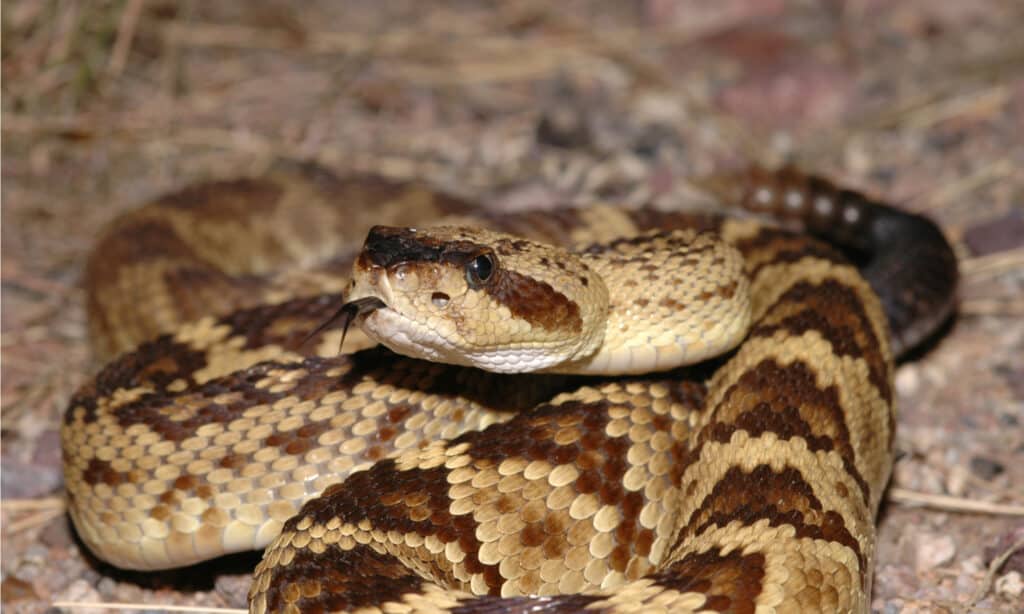
The Black-Tailed Rattlesnake is sometimes called the “dog-faced rattlesnake,” the “dog-headed rattlesnake”, the “velvet-tail rattlesnake”, or the “green rattler.
©Rusty Dodson/Shutterstock.com
| Northern Black-Tailed Rattlesnake | |
|---|---|
| Range | All of Arizona except for some of the northeastern parts of the state. |
| Length | 24-48 inches |
The Northern black-tailed rattlesnake is common throughout most of Arizona except for some portions in the northeast. This snake is usually yellow, yellow-brown, or yellow-green, and 24-48 inches long. It is a subspecies of the black-tailed rattlesnake.
There are dark diamond markings lining the snake’s body, and a dark marking across the eyes and face that looks like a facemask. Northern black-tailed rattlesnakes living on the border of Arizona and Mexico have a beautiful and bright color pattern with very bold black patches.
These snakes have black tails just before their rattles, which is why they are called “black-tailed” rattlesnakes.
Their habitat is grasslands, rocky areas, deserts, and high pine or boreal forests. While they spend a large amount of time hidden, Northern black-tailed rattlesnakes are also good tree climbers. And their name is derived from the Latin word “crotalus molossus”, which refers to a ferocious watchdog from Molossia.
5. Desert Massasauga
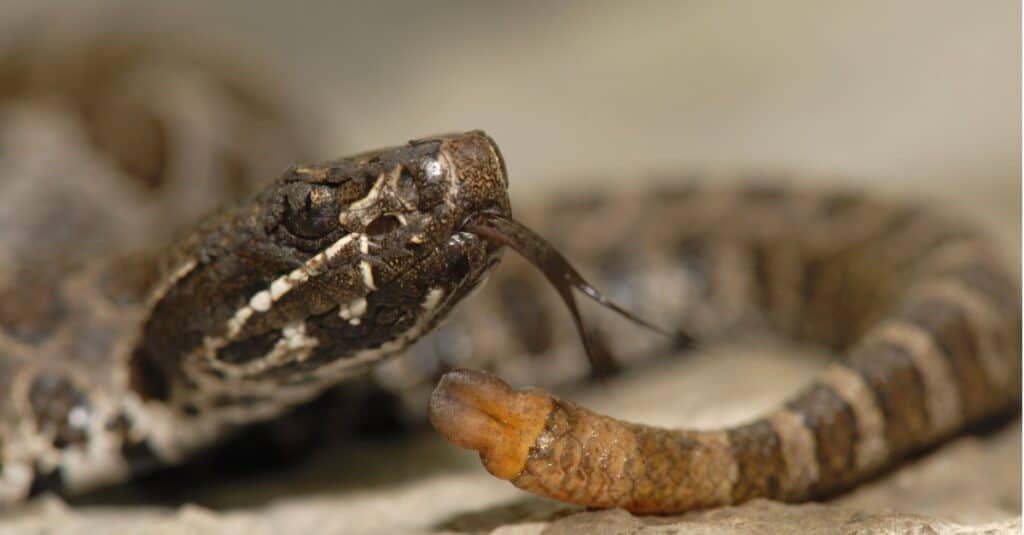
The Desert Massasauga rattlesnake is the smallest of the three subspecies of massasauga snakes.
©iStock.com/Shoemcfly
| Desert Massasauga | |
|---|---|
| Range | The southeastern corner of Arizona |
| Length | 18 inches |
The Desert Massasauga only lives in the southeastern corner of Arizona in dry, rocky areas. It is a protected species in Arizona and one of the rarest snakes in the state. The desert massasauga is a smaller rattlesnake, usually around 18 inches long. It is sandy-colored (usually tan or gray), with large, brown blotches lined close together down the middle of its back.
It has a dark brown stripe along its cheek on both sides of the face, from the eye to the back corner of the mouth. There is also a very narrow white line just below this dark cheek stripe.
The desert massasauga is not an aggressive rattlesnake. These snakes are shy and generally prefer to slither away from threats and danger rather than defend or attack. The desert massasauga’s rattle is smaller and sounds more like crickets rather than the usually strong warning sound of a larger rattlesnake.
6. Tiger Rattlesnake
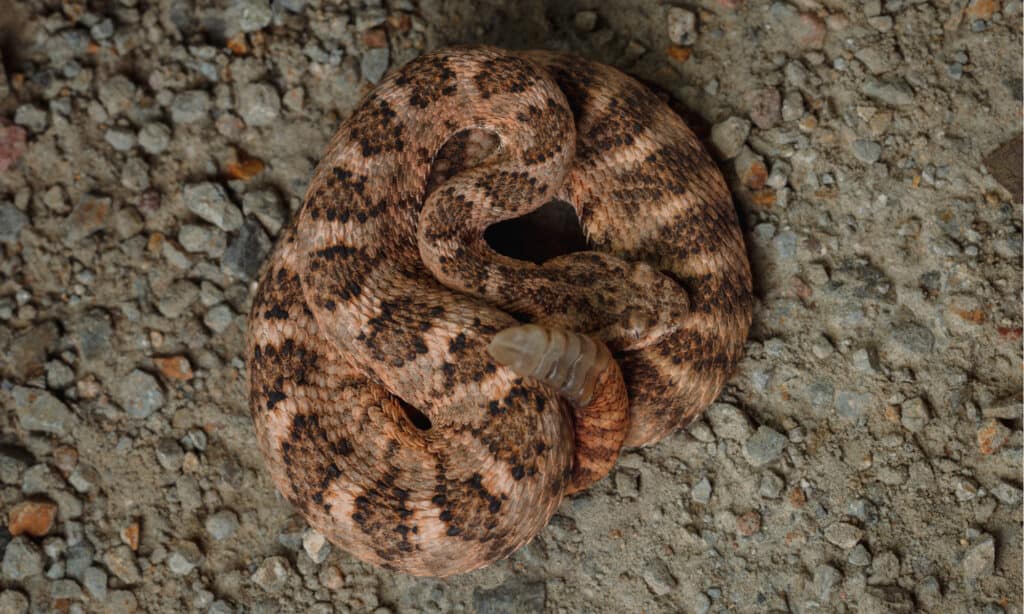
Tiger rattlesnakes have the smallest head of any rattlesnake,.
©Alexander Wong/Shutterstock.com
| Tiger Rattlesnake | |
|---|---|
| Range | Central & South-Central Arizona |
| Length | 18-36 inches |
The Tiger rattlesnake lives in central and south-central Arizona and Mexico. This snake grows to be around 18-36 inches long. The tiger rattlesnake has a gray, blue-gray, buff, lavender, or pink base color, with stripes running along its body like a tiger.
It has a rather small head compared to the rest of its body–smaller than any other rattlesnake species.
The tiger rattlesnake has a very toxic venom, much like the Mojave toxin. These snakes eat small mammals like rodents and sometimes lizards. However, they also sometimes go after larger prey like deer mice, spiny lizards, kangaroo rats, and packrats.
7. Sidewinder Rattlesnake

Sidewinders get their name from their unique form of side-stepping locomotion which is an adaptation for moving across loosely packed desert sands.
©Roger de Montfort/Shutterstock.com
| Sidewinder Rattlesnake | |
|---|---|
| Range | Sonora Desert in Southwestern Arizona |
| Length | 17-30 inches |
The Sidewinder Rattlesnake lives in southwestern Arizona in the Sonora Desert. Sidewinders are 17-30 inches long, with unique horn-like scales above their eyes.
These snakes have colors and patterns to blend into sand and sandy soil. They are usually yellow, tan, cream, or light pink, with dark blotches and small dark speckled marks along the length of their bodies. Sidewinders often bury themselves in the sand as they wait for a potential meal to pass by.
This snake’s name comes from its unique method of locomotion. Sidewinder snakes crawl sideways! This unique method of locomotion helps the snake easily move across hot, loose sand without getting burned or overheating.
All three subspecies of sidewinders are found in Arizona: the Sonoran sidewinder, the Mojave Desert sidewinder, and the Colorado Desert sidewinder.
8. Arizona Ridge-Nosed Rattlesnake

The Arizona Ridge-Nosed Rattlesnake has a series of upturned scales that create a distinct ridge along the sides of its nose.
©Matt Jeppson/Shutterstock.com
| Arizona Ridge-Nosed Rattlesnake | |
|---|---|
| Range | South-Central Arizona |
| Length | 18-30 inches |
The Arizona Ridge-Nosed Rattlesnake lives in south-central Arizona. This snake is a subspecies of the ridge-nosed rattlesnake and is the most recently discovered rattlesnake in the United States. All ridge-nosed rattlesnakes have a distinct ridge along the sides of their nose, created by a series of upturned scales. The Arizona ridge-nosed rattlesnake is the official state reptile of Arizona and is protected by state law.
The Arizona ridge-nosed rattlesnake is 18-30 inches long. This snake is dark brown with white or pale stripes spaced out along the length of its body. Its face has very distinctive pale or white stripes across it. Arizona ridge-nosed rattlesnakes are rare and are quite shy in nature. The survival of this beautiful rattlesnake depends on the protection of its mountain forest habitat.
9. New Mexico Ridge-Nosed Rattlesnake
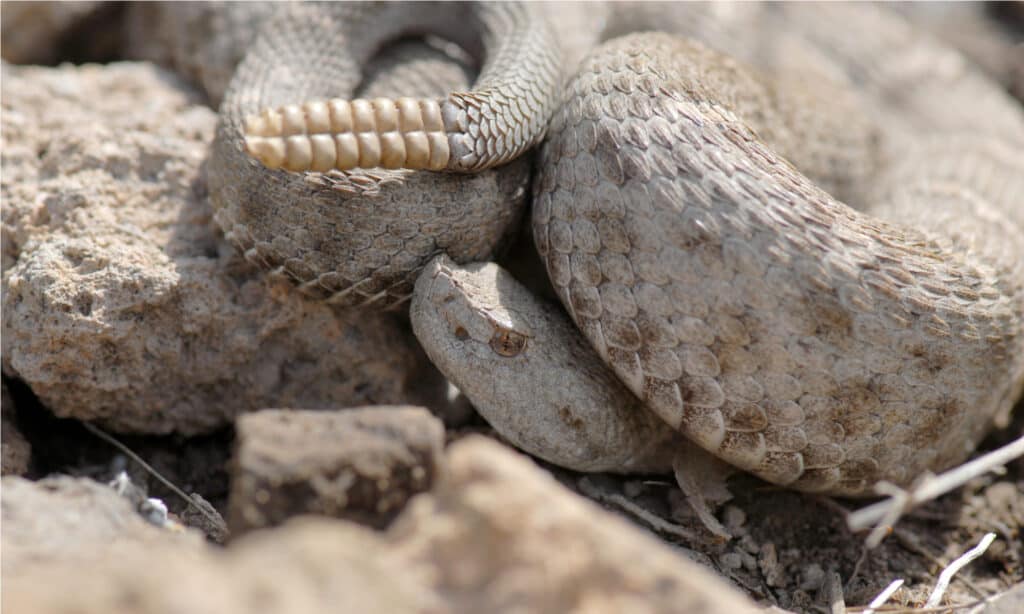
The New Mexico Ridge-Nosed Rattlesnake is sometimes called the ‘Animas Ridge-Nosed Rattlesnake’ because it is found in the Animas Mountains.
©Rusty Dodson/Shutterstock.com
| New Mexico Ridge-Nosed Rattlesnake | |
|---|---|
| Range | Extreme Southeast Arizona |
| Length | 20-24 inches |
The New Mexico Ridge-Nosed Rattlesnake only lives in the extreme southeast of Arizona. Its habitat also crosses into southwest New Mexico and parts of Mexico. This snake is a subspecies of the ridge-nosed rattlesnake. Like their name, these snakes have a group of scales along their noses that create a tangible “ridge.” The New Mexico ridge-nosed rattlesnake is an endangered species.
These snakes are 20-24 inches long with dull shades of gray, red-gray, brown-gray, and sandy-gray that help them to camouflage with their surroundings. There are lighter bands or rings along the length of their bodies, as well as dark splotches. Some of the New Mexico ridge-nosed rattlesnakes may have white stripes across their faces like the Arizona ridge-nosed rattlesnake, but these marks are extremely faded when present.
10. Arizona Black Rattlesnake
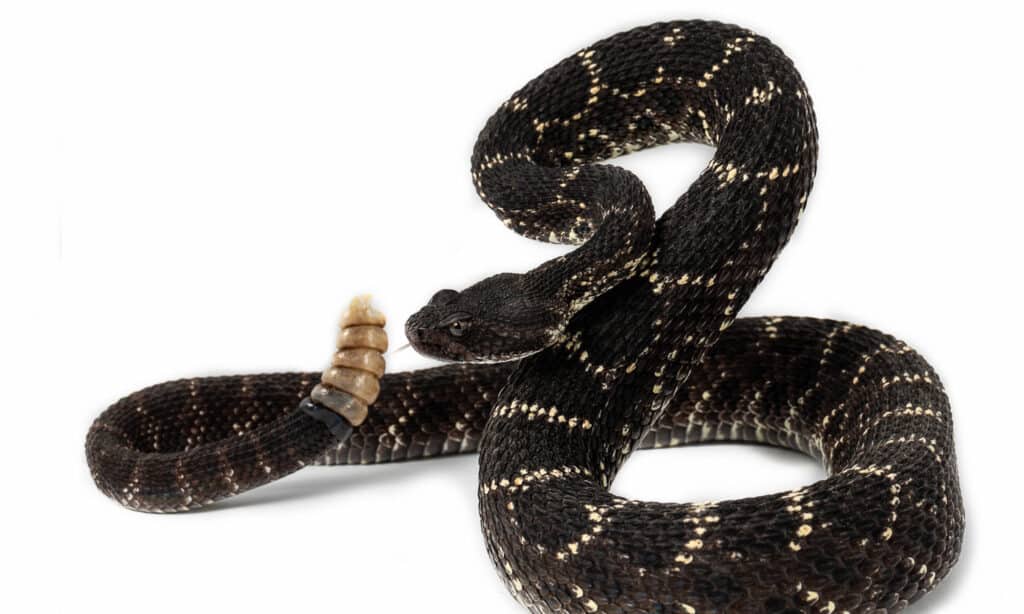
Arizona black rattlesnakes share communal dens and females may share parenting duties.
©Scott Delony/Shutterstock.com
| Arizona Black Rattlesnake | |
|---|---|
| Range | Central Arizona |
| Length | 24-48 |
The Arizona Black Rattlesnake only lives in central Arizona and the extreme western portion of New Mexico. These snakes are 24-48 inches long and are various shades of black and gray, with even darker blotches running along the length of their bodies.
Some snakes may have light ring patterns between the darker blotches. The Arizona black rattlesnake is also called the black rattlesnake, the black diamond rattlesnake, and the Cerberus rattlesnake.
11. Banded Rock Rattlesnake
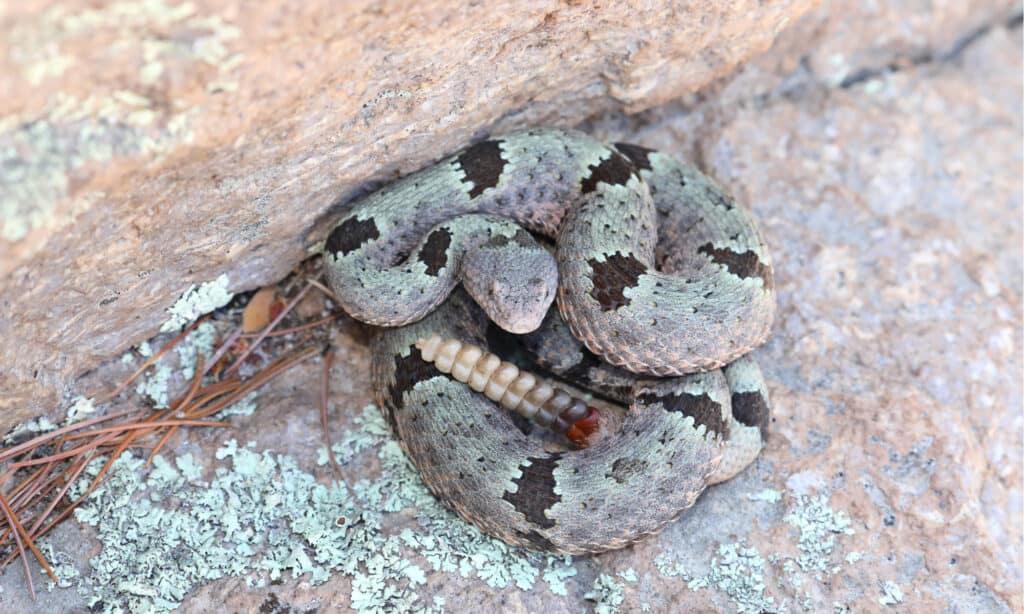
The Banded Rock Rattlesnake doesn’t travel very far and usually lives its entire life in the same area.
©Glenn McCrea/Shutterstock.com
| Banded Rock Rattlesnake | |
|---|---|
| Range | The southeastern corner of Arizona |
| Length | 23-27 inches |
The Banded Rock Rattlesnake only lives in rocky areas in the southeastern corner of Arizona. This snake is a subspecies of the rock rattlesnake and can blend into rocky environments with ease. The banded rock rattlesnake is 23-27 inches long, with black or gray banded markings.
These markings contrast beautifully with their dark green or gray body, making the banded rock rattlesnake a very eye-catching reptile. However, because of its unique appearance, this snake is often the victim of human interaction, so the banded rock rattlesnake is protected by Arizona state laws. Banded rock rattlesnakes are nonaggressive but can be nervous. These snakes are shy and do their best to avoid large predators and humans.
12. Twin-Spotted Rattlesnake

The twin-spotted rattlesnake (
Crotalus pricei) is a venomous snake found mainly in southeastern Arizona and Northern Mexico.
©iStock.com/adogslifephoto
| Twin-Spotted Rattlesnake | |
|---|---|
| Range | Southeastern Arizona |
| Length | 18-26 inches |
The Twin-Spotted Rattlesnake lives in the high mountain forests of southeastern Arizona and Durango, Mexico. This snake grows to be 18-26 inches long and is usually reddish-brown, light brown, tan, gray, gray-brown, or blue-gray. Its scales are rough and splattered with tiny speckles.
The twin-spotted rattlesnake gets its name from the two parallel rows of distinct dark patches running along its back. It also has a dark cheek stripe from each eye to the back of the mouth. Twin-spotted rattlesnakes are a protected species in Arizona.
13. Great Basin Rattlesnake (Western Rattlesnake)
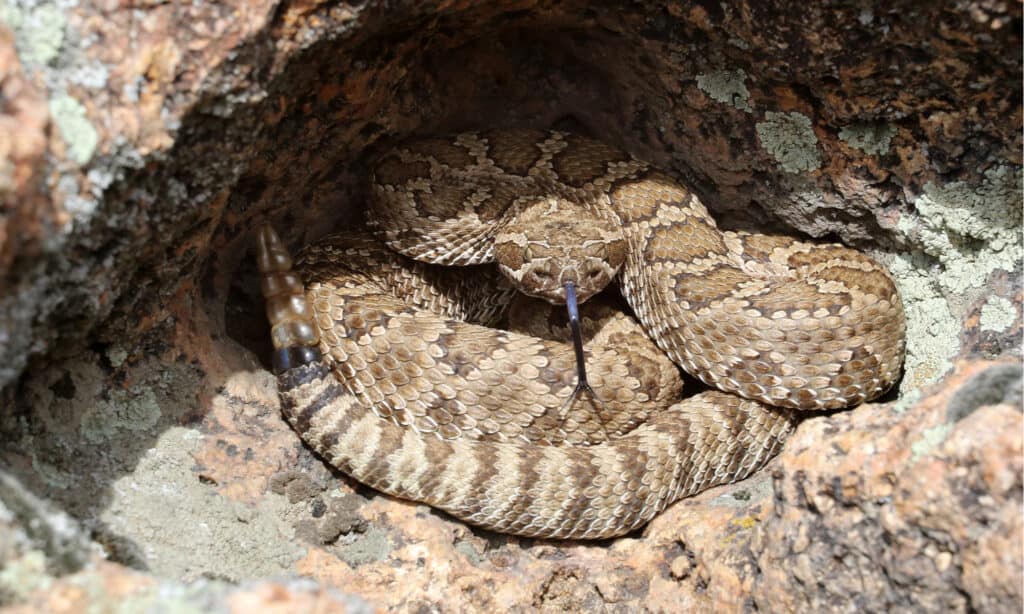
Great Basin Rattlesnakes and the Great Basin gopher snake are very similar in appearance.
©Randy Bjorklund/Shutterstock.com
| Great Basin Rattlesnake | |
|---|---|
| Range | Northwestern Arizona |
| Length | 24-48 inches |
The Great Basin Rattlesnake lives in the northwest of Arizona, where it ranges in length from 24-48 inches long. In Arizona this snake’s colors vary, with base colors of yellow, yellow-brown, olive brown, gold, cream, or gray, often permeated with pastel shades of pink, orange, and taupe.
Some snakes blend into their environment, while others seem to contrast and stand out quite a bit. Great Basin rattlesnakes also have dark blotches along their backs that contrast with the light base color of their thick bodies.
Two nonvenomous snakes—the Sonoran gopher snake and the Great Basin gopher snake—look a lot like the Great Basin rattlesnake. However, these two snakes are harmless to humans. If you are out hiking and see what appears to be a rattlesnake, it might very well be a gopher snake. In either case, however, you should always give the snake a wide berth and leave it alone.
14. Grand Canyon Rattlesnake (Western Rattlesnake)
[Image needed – Grand Canyon Rattlesnake / Caption “The Grand Canyon Rattlesnake was discovered by the naturalist Edwin “Eddie” McKee, who was so enamored by this pink rattlesnake that he sent it to the San Diego Zoo.”]
| Grand Canyon Rattlesnake | |
|---|---|
| Range | Central and Northwestern Arizona in the Grand Canyon |
| Length | 24-60 inches |
The Grand Canyon Rattlesnake lives only in the Grand Canyon in central and northwest Arizona. It is a subspecies of a Western rattlesnake, growing 24-60 inches long. Another name for this snake is the “Grand Canyon Pink Rattlesnake”, due to its unique pink color.
The colors of the Grand Canyon Rattlesnake reflect the different rock layers of the Grand Canyon itself, like pink, light tan, red, yellow-green, and gray. This allows them to blend in with their surroundings. The darker blotches along their backs often fade as they get older.
15. Prairie Rattlesnake & Hopi Rattlesnake
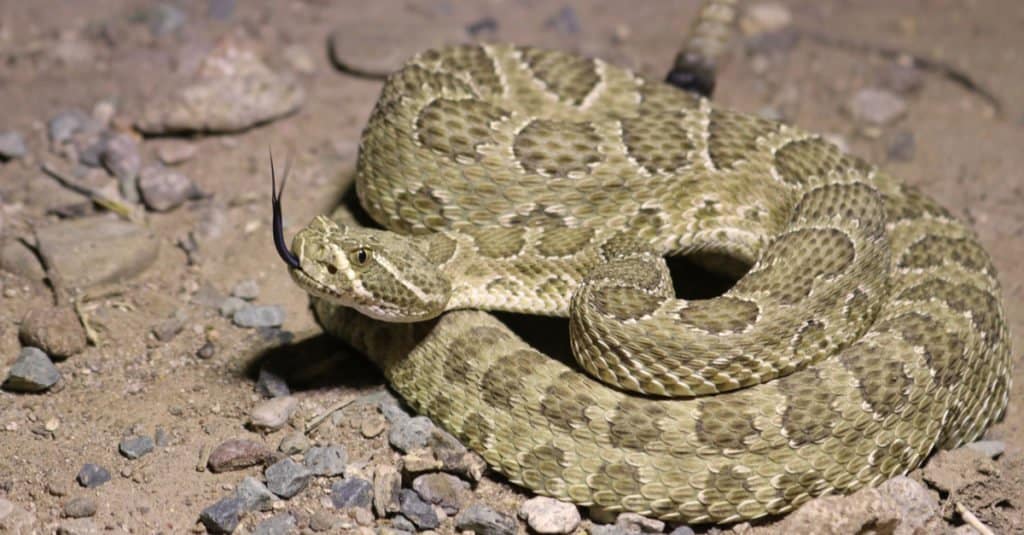
Prairie rattlesnakes spend most of their time slithering on the ground but they can also climb trees, navigate bushes, and are known to hide in rock crevices or small caves.
©Creeping Things/Shutterstock.com
| Prairie Rattlesnake & Hopi Rattlesnake | |
|---|---|
| Range | Northeastern Arizona |
| Length | 36-48 inches (Prairie); 24 inches (Hopi) |
The Prairie Rattlesnake (also called the Great Plains Rattlesnake) lives in northeastern Arizona. This snake’s appearance depends on its habitat, as its colors help it to blend in with its surroundings. Prairie rattlesnakes can be brown, tan, red, or orange, with white-rimmed dark splotches along the length of their bodies. These snakes are 3-4 feet long with “keeled” or texturized scales.
The Hopi Rattlesnake is a subspecies of the prairie rattlesnake. This snake looks very similar to the prairie rattlesnake, but it is only about 24 inches long. In Arizona, these snakes are usually brown, tan, or green. Because of this, Hopi rattlesnakes are sometimes confused with Mojave Green Rattlesnakes in Arizona.
Hopi rattlesnakes are secretive and guarded, usually hiding under rocks or in burrows to escape the heat. Although they are not usually considered aggressive, these snakes will attack quickly if they feel unsafe.
The Hopi Rattlesnake gets its name from the Hopi Native American tribe, who see these snakes are rain guardians. The Hopi people use Hopi rattlesnakes in some of their ceremonies as a way to honor it and to pray for rain (no harm comes to the snake).
Summary of 15 Types of Rattlesnakes in Arizona
Take one more look at 15 different rattlesnakes that inhabit the great state of Arizona:
| Rank | Type |
|---|---|
| 1 | Western Diamondback Rattlesnake |
| 2 | Mojave Rattlesnake |
| 3 | Speckled Rattlesnake |
| 4 | Northern Black-Tailed Rattlesnake |
| 5 | Desert Massasauga |
| 6 | Tiger Rattlesnake |
| 7 | Sidewinder Rattlesnake |
| 8 | Arizona Ridge-Nosed Rattlesnake |
| 9 | New Mexico Ridge-Nosed Rattlesnake |
| 10 | Arizona Black Rattlesnake |
| 11 | Banded Rock Rattlesnake |
| 12 | Twin-Spotted Rattlesnake |
| 13 | Great Basin Rattlesnake |
| 14 | Prairie & Hopi Rattlesnake |
| 15 | Grand Canyon Rattlesnake |
What Animals Live in Arizona?
Arizona is home to a diverse array of wildlife, including both native and introduced species. Here are some of the animals that can be found in Arizona:
- Cougars: Also known as mountain lions, cougars are native to Arizona and are the largest predator in the state.
- Black Bears: Black bears are found in the northern and eastern regions of Arizona and are omnivores, feeding on both plants and animals.
- Elk: Elk are found in the northern regions of Arizona and are a popular game species for hunters.
- Bighorn Sheep: Bighorn sheep are found in the mountainous regions of Arizona and are well-known for their impressive horns.
- Javelina: Javelinas are a type of peccary that are native to Arizona and are often referred to as “collared peccaries”.
- Desert Bighorn: The desert bighorn is a type of bighorn sheep that is well-adapted to life in the hot, arid conditions of Arizona’s deserts.
- Gila Monster: The Gila monster is a venomous lizard that is found in the deserts of Arizona and is the only venomous lizard in the United States.
- Coyote: Coyotes are common in Arizona and are known for their adaptability and versatility. They are found in a variety of habitats, from deserts to forests.
These are just a few of the many species of wildlife that can be found in Arizona. Whether you are a wildlife enthusiast, birdwatcher, or just someone who loves the great outdoors, Arizona is an excellent place to explore and observe these fascinating creatures.
What State Has the Most Snake Attacks?

The venomous copperhead snake is among the snakes responsible for snake bites in North Carolina.
©iStock.com/David Kenny
There’s no denying that there’s a large variety of rattlesnake species in Arizona, all of which have venomous bites. Every year, approximately 200 rattlesnake bites are reported in the state with an estimated 250-350 snake bites occurring annually, as some go unreported. But what U.S. state ranks the highest in snake bites? That would be North Carolina. This southeastern state’s bite rate is 157.8 bites per million population per year. How does that average out? Well, the population as of 2021 was a little over 10 million (10.55 to be exact). If we were to just figure it off of 10 million, that would mean that there are roughly 1,580 reported snake bites per year.
The top 6 states for reported snake bites are as follows:
- North Carolina–157.8 bites per million
- West Virginia–105.3 bites per million
- Arkansas–92.9 bites per million
- Oklahoma–61 bites per million
- Virginia–48.7 bites per million
- Texas–44.2 bites per million
In North Carolina, there are 6 different kinds of venomous snakes: copperhead, cottonmouth, timber rattlesnake, pigmy rattlesnake, eastern diamondback rattlesnake, and eastern coral snake. In 2019, 92 people were bitten by venomous snakes in that state.
The photo featured at the top of this post is ©
Discover the "Monster" Snake 5X Bigger than an Anaconda
Every day A-Z Animals sends out some of the most incredible facts in the world from our free newsletter. Want to discover the 10 most beautiful snakes in the world, a "snake island" where you're never more than 3 feet from danger, or a "monster" snake 5X larger than an anaconda? Then sign up right now and you'll start receiving our daily newsletter absolutely free.
Thank you for reading! Have some feedback for us? Contact the AZ Animals editorial team.






